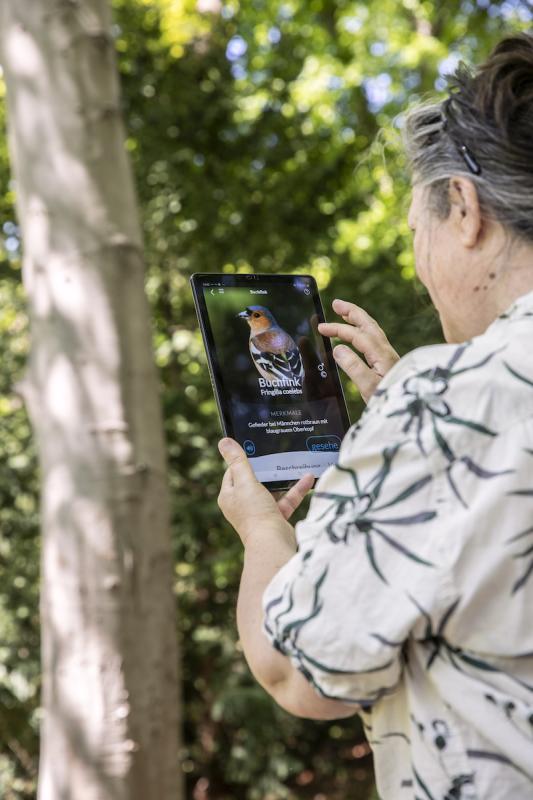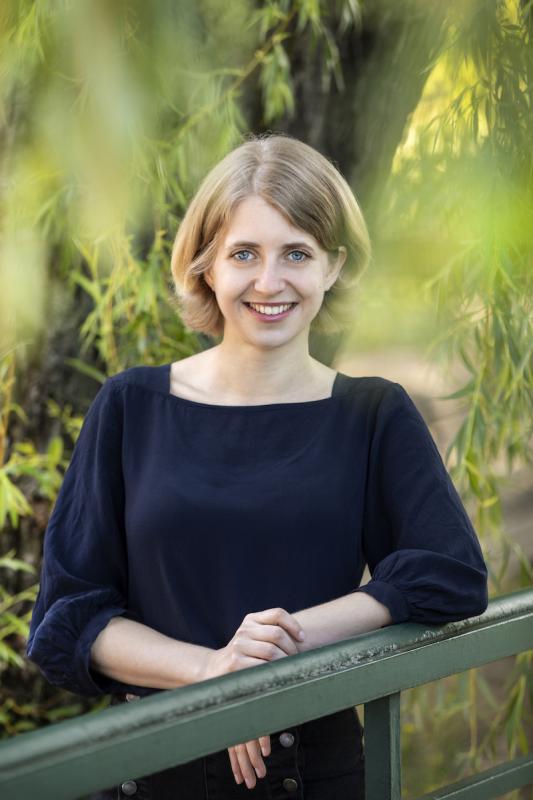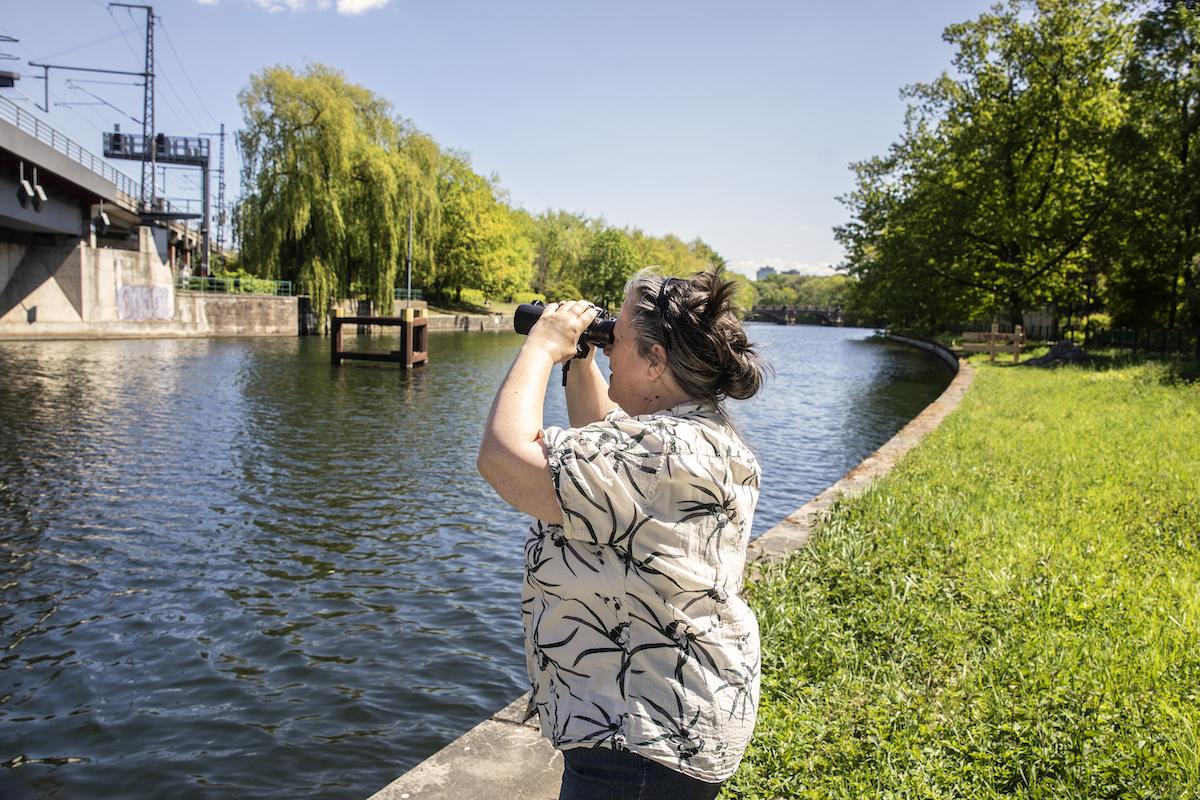This article was first published in our journal For Nature (issue 2/2020).
Identifying birds, observing wild bees: Citizen research is booming. Because anyone can research and it's fun!
"There is a bird of prey circling": Hobby ornithologist Christine Kuhnert points to the blue sky. In the middle of Berlin, at the Bellevue S-Bahn station between the railway bridge and the Spree, she quickly pulls out her binoculars to identify the species. "A common buzzard", of that Kuhnert is certain. When she is on the bird hunt, binoculars are her most important tool, followed by her tablet. Because she installed the Naturblick app developed by the Museum für Naturkunde Berlin on it. If in doubt, she can find help with species identification here. Thanks to the free app, she no longer needs to lug around identification books with her.
"If you want to identify birds, you can simply open the app and record the song – and the app will present a list of results," says Christine Kuhnert. And what she particularly likes: The Naturblick app is not only a good tool for bird calls. Other animals and plants can also be quickly identified. The 64-year-old, who volunteers bird tours for children and adults all over Berlin, recommends beginners: inside identification apps such as the Naturblick app. In this way, you can discover Berlin's urban nature independently and without contact in corona times. Naturblick is funded by the Federal Ministry for the Environment, Nature Conservation and Nuclear Safety.
"It's great to introduce children to nature observation," says Kuhnert. Because of Covid, her bird tours and her nature children's group will be canceled for the time being. And so the trained tax clerk is currently more in the Spandau instead of on the Tempelhofer Feld or in the Tiergarten park. Did she notice any changes in the birds during the pandemic? "My subjective impression is that the birds are somehow a little more relaxed," she laughs.

Observe plants and bees in community gardens
Are nature observations by non-biologists always the same as citizen research? "We developed the Naturblick app for environmental education," says Ulrike Sturm, project manager at the museum. "With it we want to get people excited about nature and impart knowledge." At the same time, the app can be used for Citizen Science: "All observations are saved and can then be scientifically evaluated," says Sturm. "We always speak of Citizen Science when the citizens contribute to answering a specific research question."
"Citizen science is booming at the moment. This was made possible by new technologies, among other things. With smartphones, for example, nature observations with GPS coordinates can be collected quickly and easily anywhere for science and nature conservation," emphasizes Sturm.
The number of projects is growing. The Bürger schaffen Wissen portal has been available since 2013 for a Germany-wide overview. Here you will find numerous initiatives that everyone can participate in. This year the EU-Citizen.Science platform was launched, which networks Citizen Science projects in Europe. The Bees, pollination and citizen science project in Berlin's gardens has been new this spring. Together with the TU Berlin, the researchers at the museum are observing plants in over 20 Berlin community gardens. They hope for answers to the questions: How can urban gardens contribute to wild bee protection in Berlin? How can gardeners and urban planners support wild bees and their pollination effect in community gardens?
"To do this, gardeners observe the pollination of tomato, pumpkin and pepper plants," says Sturm, describing the procedure. "They document when the plants bloom, when they are pollinated and when they bear fruit. When they are harvested, they measure the size of the fruits". Researchers at TU Berlin are simultaneously documenting bees and the characteristics of the gardens in these gardens. The gardeners and the project team then use the results to formulate measures to protect wild bees in the community gardens.

Because the workshops could not take place in person due to the risk of infection, there were quick online meetings and videos. Observing and documenting nature is also possible without contact in corona times.
The museum has been committed to citizen research and the opening up of science for years. A citizen science center is currently being built; at the same time, the Berlin School of Public Engagement and Open Science will be founded this year to strengthen science communication. Citizen research is an integral part of this. In addition to opening up science, participation in science is one of the pillars of the science campus for nature and society, which the museum is developing with the Humboldt Universität zu Berlin over the next few years.
The importance of citizen research is growing because it brings added value for science. Because there are a number of data holes in science. For example, when it comes to measuring water pollution or air quality worldwide. The potential of Citizen Science is huge, as citizens can collect data directly on site. From 14 to 15 October 2020, the museum is organizing an international Citizen Science conference sponsored by the European Commission. "Anyone can research! We encourage Berliners to be eager to learn, to ask questions and to pass on knowledge. Because we at the Museum für Naturkunde Berlin are convinced that when society and science work together, both sides win," says Silke Voigt -Heucke, head of the Citizen Science Center.
Who knows, maybe all you need for the next citizen research project is an open window, binoculars and a smartphone. Christine Kuhnert is one of the people who will take part right away: "The great thing about observing birds is that I can still do it at the age of 95 from the window of a retirement home – because birds sing in front of every window."
Text: Carmen Schucker
Pictures: Pablo Castagnola
